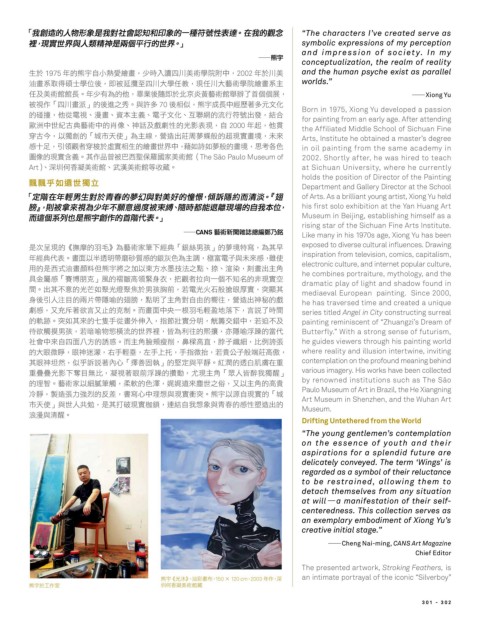Page 341 - 亚洲二十世纪及当代艺术
P. 341
Ң௴ிٙɛيҖ݊Ң࿁ٟึႩٝձΙٙɓ၇ୌڌ༺fίҢٙᝈׂ “The characters I’ve created serve as
༁dତྼ˰ޢၾɛᗳၚग़݊Շࡈ̻Бٙ˰ޢf symbolic expressions of my perception
and impression of society. In my
{ ဤρ
conceptualization, the realm of reality
͛ 1975 ϋٙဤρІʃᆠฌᖭdˇࣛɝᛘ̬ʇߕஔኪ৫ڝʕd2002 ϋʇߕ and the human psyche exist as parallel
ذӻ՟၂ɻኪЗܝdуַᜡЇ̬ʇɽኪdତʇɽᖵஔኪ৫ᖭӻ˴ worlds.”
ʿߕஔڗfϋˇϞމٙ˼dଭุܝᎇу̏ԯفරᖵஔᑘ፬əࡈࡈ࢝d — Xiong Yu
ൖЪ̬ʇݼٙܝආʘӸfၾε 70 ܝЧdဤρϓڗʕዝഹεʩ˖ʷ Born in 1975, Xiong Yu developed a passion
ٙຠᅜd˼ཥൖeဘe༟͉˴່eཥɿ˖ʷeʝᑌၣٙݴБୌ̈೯dഐΥ for painting from an early age. After attending
ᆄݲʕ˰ߏ̚Պᖵஔʕٙӽ྅eग़༑ʿᏕᄌٙΈᅂڌତdІ 2000 ϋৎd˼ the Affiliated Middle School of Sichuan Fine
߈̚ʦd˸ዹ௴̹ٙ۬˂Դމ˴ᇞdᐄி̈մྫྷሁছٙ൴ତྼྤd͊Ը Arts, Institute he obtained a master’s degree
ชɤԑdˏჯᝈ٫߈ൈྼ͛ٙᖭ˰ޢʕdᔟν་νྫྷছٙྤdܠϽЍ in oil painting from the same academy in
ྡ྅ٙତྼў່fՉЪۜಀˋГ໋ڭᖯߕஔThe São Paulo Museum of 2002. Shortly after, he was hired to teach
ArteଉέО࠰ኑߕஔe؛ဏߕஔഃϗᔛf at Sichuan University, where he currently
holds the position of Director of the Painting
ᙗᙗ˷ν፲˰ዹͭ Department and Gallery Director at the School
֛චίϋჀӲ͛࿁ڡ݆ٙྫྷˌၾ࿁ߕλٙᅏᅓdහൡᒯߒϾ૱fॼ of Arts. As a brilliant young artist, Xiong Yu held
ၶdۆࣅԸൖމˇϋʔᗴจཀܓҼጣeᎇࣛேঐৗᕎତఙٙІҢ͉Зd his first solo exhibition at the Yan Huang Art
Ͼவࡈӻΐɰ݊ဤρ௴Ъٙච˾ڌf Museum in Beijing, establishing himself as a
rising star of the Sichuan Fine Arts Institute.
{ CANS ᖵஔอၲᕏႦᐼᇜቍɗთ
Like many in his 1970s age, Xiong Yu has been
݊ϣяତٙᅨᅙٙϻˣމᖵஔഅɨՊვകӲ܀ٙྫྷྤतᄳdމՉϘ exposed to diverse cultural influences. Drawing
ϋՊ˾ڌfࠦ˸̒ீ੭ጋሯชٙვϲЍމ˴ሜdబཥɿၾ͊ԸชdᒱԴ inspiration from television, comics, capitalism,
ٙ݊͜ГόذᕙࣘШဤρਗ਼ʘ̋˸؇˙˥ኈҦجʘᓃeશeݑdՍ̈˴ԉ electronic culture, and internet popular culture,
he combines portraiture, mythology, and the
Ոږ᙮ชᒄ௹дࠬٙᑲᆴ৷ჯၡԒВdҪᝈ٫זΣɓࡈʔٝΤٙڢତྼ٤ dramatic play of light and shadow found in
ගf̈ՉʔจٙΈԅνၳΈዱၳೊӲ܀ۃd߰ཥΈ˦ͩছวێྼd߉ᜑՉ mediaeval European painting. Since 2000,
ԒܝˏɛءͦٙՇ˪੭ᒯఏٙॼၶdᓃə˴ԉ࿁Іٙ͟ᓋֻdᐄி̈ग़।ٙᏕ he has traversed time and created a unique
ᄌชdɦ̂͆ഹ૧Ԋɦ˟ٙдՓfϾࠦʕ̯ɓ࣬ϻˣჀޮήໝɨdԊႭəࣛග series titled Angel in City constructing surreal
ٙࠐ༦f߉νՉԸٙɖ৳˓̮Фɝdܸືѯྼʱd▃ᘪʹ፹ʕd߰ࠗʔʿ painting reminiscent of “Zhuangzi’s Dream of
ܙ૧ᙃӲ܀d߰ฮఏيᅎዑݴٙ˰ޢ༁dޫމлֻٙဢᘖd͵ᒯఏओᙍٙ˾ Butterfly.” With a strong sense of futurism,
ٟึʕԸІ̬ࠦɞ˙ٙႰfϾ˴ԉᑕ᎔ᆰۂdᄀᆃ৷ٜd୫ɿᜄdˢԷ།ੵ he guides viewers through his painting world
ٙɽฆບdग़ᏸd̛˓Ⴠۧd̸˓ɪϖd˓ܸฆױd߰൮ʮɿছ၌৷ශd where reality and illusion intertwine, inviting
Չग़վ್dЧ˷ൡႭഹʫːഛոੂ֛ٙၾ̻᎑fߎᆗٙீͣЄᇮίࠠ contemplation on the profound meaning behind
ࠠᛌᛌΈᅂɨྮͦೌˢdኑൖഹۃओᙍٙ㎄ਗdˈତ˴ԉɛޫቑҢዹ፴ various imagery. His works have been collected
ٙଣ౽fᖵஔ˸ጰഅᙃdݓழٙЍዣdࢉࢉ༸Ըྡྷ˰ʘڳdɦ˸˴ԉٙ৷൮ by renowned institutions such as The São
и᎑dႡிੵɢ੶डٙˀࢨdࣣᄳːʕଣซၾତྼላ߉fဤρ˸๕Іତྼٙ۬ Paulo Museum of Art in Brazil, the He Xiangning
Art Museum in Shenzhen, and the Wuhan Art
̹˂Դၾ˰ɛۈd݊Չ͂ॎତྼᬞᕁdஹഐІҢซၾڡ݆ٙช෧ி̈ٙ Museum.
ईဘၾ፴f
Drifting Untethered from the World
“The young gentlemen’s contemplation
on the essence of youth and their
aspirations for a splendid future are
delicately conveyed. The term ‘Wings’ is
regarded as a symbol of their reluctance
to be restrained, allowing them to
detach themselves from any situation
at will{a manifestation of their self-
centeredness. This collection serves as
an exemplary embodiment of Xiong Yu’s
creative initial stage.”
— Cheng Nai-ming, CANS Art Magazine
Chief Editor
The presented artwork, Stroking Feathers, is
ဤρΈӕdذ̺d150 Ò 120 cmd2003 ϋЪdଉ an intimate portrayal of the iconic “Silverboy”
ဤρʈЪ܃ έО࠰ኑߕஔᔛ
3 01 - 3 0 2

